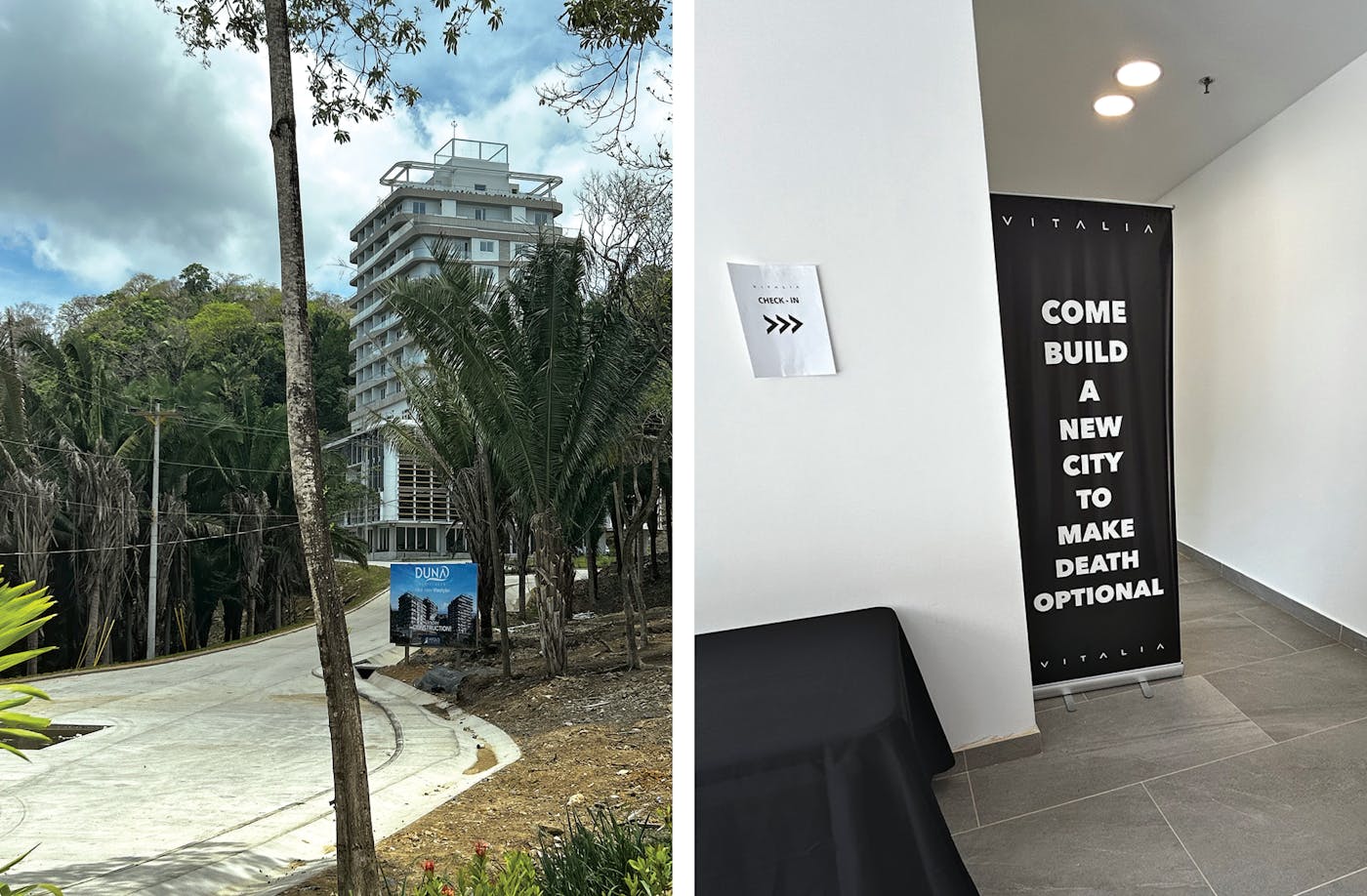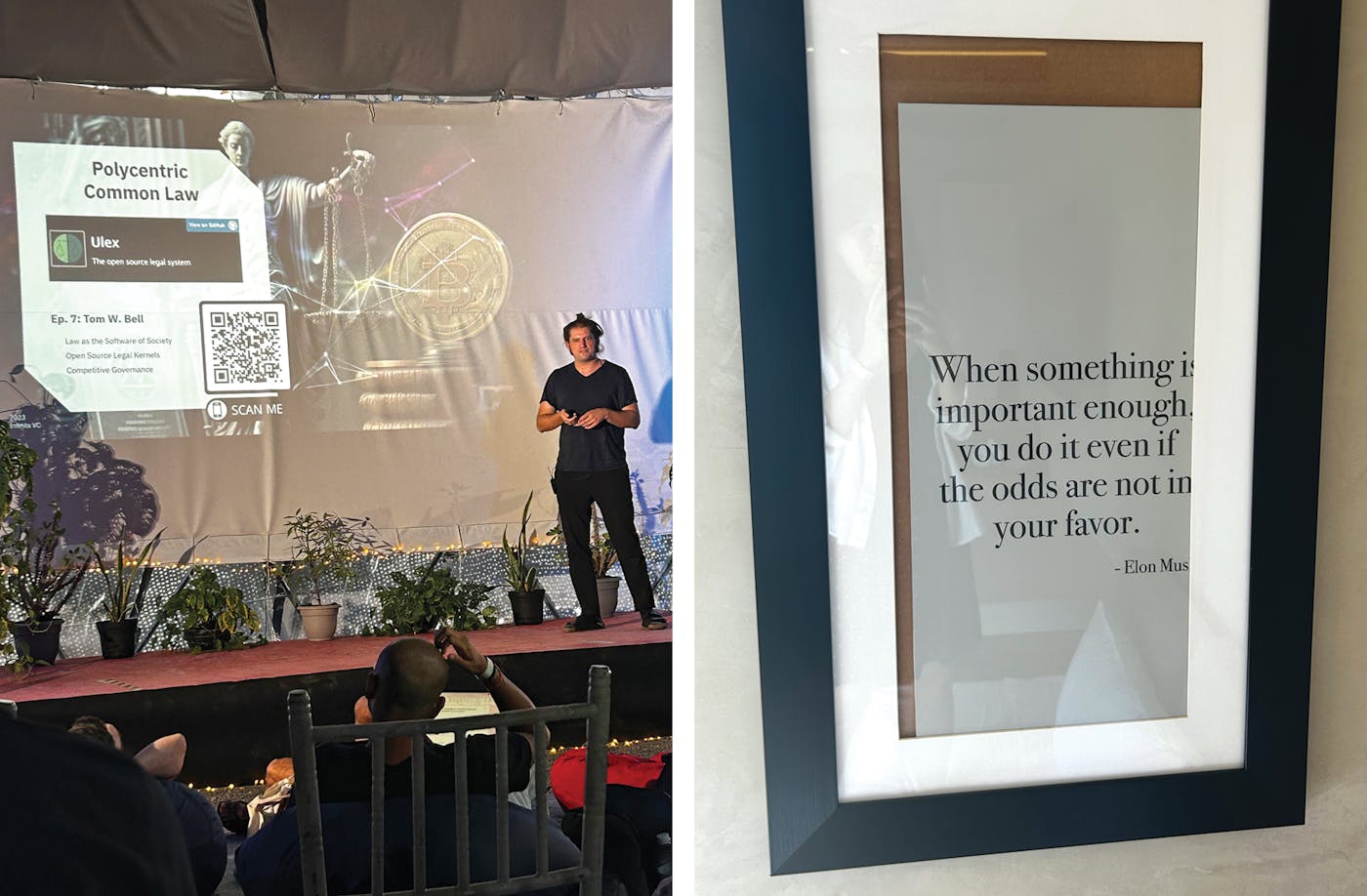In July 2024, I flew to a pop-up city named Vitalia that aimed to “make death optional.” Situated in the heart of a special economic zone on Roatan, a Honduran island, Vitalia advertised itself as a place to fast-track drug research outside of America’s burdensome regulatory constraints.
The AI-generated pictures I’d seen made it look sleek and futuristic, like a cross between South Beach Miami and The Jetsons. Since its launch seven months before, Vitalia had attracted scientists, entrepreneurs, and crypto enthusiasts—among them longevity guru Bryan Johnson and Balaji S. Srinivasan, the author of The Network State. The special economic zone in which Vitalia was located, Próspera, claimed on its website that a company could go to market 10 to 100 times faster there than the United States, which requires three phases of trials—testing first for safety, then for dosage and efficacy within a given population—before a product can be advertised or sold. Many drugs fail in what’s called the “valley of death” between promising early studies and the outcome of Phase 2 or 3 trials; 90 percent of drugs don’t make it through a process that can, all told, cost hundreds of millions of dollars.
Vitalia joined a growing number of special economic zones and bespoke cities sprouting up around the world, usually to provide some form of relaxed taxation or regulation. Many are targeting medical innovation, trying to attract a new class of scientist you might call clinical nomads—those attempting to do research outside the traditional pathways. A 2022 report found that 82 special economic zones were attempting to lure genetic engineering startups to set up shop. India’s Genome Valley is hosting around 200 companies that will enjoy streamlined regulatory approval. Dubai Science Park offers 100 percent tax-free status to foreign-owned companies focused on the life sciences. The Technopolis Moscow Special Economic Zone, in Russia, is testing three gene therapies derived from a person’s own cells.
My parents work in biotech, and I am familiar with the headaches of lengthy and expensive clinical trials, the arduous path a scientist has to follow to make a medicine that can safely be given to humans. I was curious about cities like Vitalia and their pledges of regulatory freedom. I would be attending the Accelerate & Live Forever summer program, which included discussions on decentralized science and biohacking, but I was looking for something more than panels and talks. In the coming years, the United States is poised to undergo significant medical deregulation of its own. Health Secretary Robert F. Kennedy Jr. has said that he wants to heavily strip Food and Drug Administration regulations and speed up the approval process for new gene and cell therapies. In an executive order, Donald Trump wrote that for every federal regulation kept, 10 must be cut—a rule the FDA has said it will follow. What, I wondered, will a future of clinical trials moving at breakneck speed actually look like? How risky is it? Vitalia seemed like it might offer some answers.
Humidity engulfed the plane the minute we hit the runway, steaming up the windows. I got into the back of a taxi and showed my driver a pin on the map. “Próspera?” I said, as he looked blankly back at me. He pointed to a village called Crawfish Rock, next to a newly opened residential tower in Vitalia called Duna, where I would be staying. Close enough, I thought.
The drive took us past abandoned wood-frame houses and street vendors selling clothes and plastic trinkets, until we reached a main road adjacent to a strip mall. As we turned up a steep hill, the road stopped being paved. We bumped furiously along, dodging large rocks and ditches and steering around tight corners. I tightened my seat belt. On the other side of the hill, the ocean came into view. To my right, I saw a white high-rise: Duna.
In the lobby, workers were still painting the walls. One room I peered into had a pile of unassembled gym equipment in the corner. I went to my fifth-floor studio apartment, sparsely furnished with a bed, a small couch, and a desk. One of the ceiling panels was missing, and there was an open gap in the countertop where a stove was supposed to go. It was hard to start a city from scratch, it seemed, let alone a city with no traditional government services that aims to be a center for unprecedented scientific innovation.
Backed by the likes of Silicon Valley billionaires Peter Thiel, Sam Altman, and Marc Andreessen, Próspera was founded in 2017 as a ZEDE, a Spanish acronym for Zone for Employment and Economic Development. It is essentially a for-profit district that is run by a business rather than a government. According to Erick Brimen, Próspera’s founder and CEO, this approach to governance paves the way for research by allowing for regulatory choice, meaning that a biotech company can pick its own set of laws to follow, whether that’s common law; an existing regulatory structure in a country belonging to the Organization for Economic Cooperation and Development; or a brand-new regulatory apparatus that it comes up with on its own. Instead of traditional regulatory approval, every company that operates there is required to get an insurance policy. (According to Vitalia co-founder Niklas Anzinger, as of now there is only one firm selling them: the Próspera-owned insurance firm.) After demonstrating safety, a company is able to commercialize its health care or biotech product immediately—comparable, in the United States, to going to market after Phase 1.
Vitalia, the pop-up city within Próspera, was co-founded in October 2023 by Anzinger, a German entrepreneur with a background in venture capital, and longevity investor Laurence Ion. Anzinger characterizes the current state of medical research as dire. In 2012, researchers coined the term Eroom’s Law to describe how the number of new drugs approved per billion dollars spent on research and development had been cut in half every nine years since 1950, even though technology was advancing. Vitalia’s mission, according to Anzinger, was to help founders reverse Eroom’s Law and develop biotechnology without all the red tape. He particularly objects to the need to demonstrate efficacy in clinical trials before market approval. While he has said he believes showing efficacy is important, he thinks it can be established later.
Anzinger’s ideas are textbook medical libertarianism, and largely informed by the thinking of philosopher Jessica Flanigan, who wrote a book called Pharmaceutical Freedom in 2017. Flanigan’s central argument is that, just as we have the right to refuse a treatment even if it’s not in our medical interest to do so, we should have the right to self-medicate. By her logic, you should be able to access treatments regardless of whether the FDA or a doctor would recommend them. “When the FDA restricts access to unapproved drugs, they’re taking the decision out of the hands of patients,” Flanigan told me over the phone. She thinks that the existence of off-label prescribing—when drugs are prescribed for conditions other than what they were approved for—demonstrates that, practically speaking, the efficacy testing requirement isn’t necessary, because drugs used off-label aren’t tested for those conditions.
The harms that Anzinger and Flanigan believe result from FDA regulation are huge: an “invisible graveyard full of people who died waiting” for drugs to be approved, as Flanigan put it to me. According to her, the FDA kills people by making the approval process expensive and disincentivizing pharmaceutical companies from taking risks. She suggested that it would be better off becoming something closer to Consumer Reports or Wirecutter, authenticating drugs as safe and effective without prohibiting people from accessing them.
There’s an optimism at the heart of these dark warnings about the FDA. If you think that all that’s blocking lifesaving or life-extending drugs from existence is a government agency, then of course you would want to burn it to the ground. As I looked out my window in Duna, however, I saw not a futuristic city space but dense jungle. Vitalia’s experiment in fast-tracking research was betting heavily on the idea that regulation, not imperfect medications or hard-to-treat disease, is the reason for the drug-development bottleneck. For Flanigan, the pop-up community is a compelling gamble. “I think it’s an exciting way of approaching health care,” she said.
Although Roatan is the largest island off the coast of Honduras, it is only 40 miles long. Its West End is a common tourist destination for cruise ship passengers, and because of its proximity to the Mesoamerican Barrier Reef, it has some of the best scuba diving in the world. Próspera is in the island’s center, where there’s not as much development. Essentially a network of buildings, it includes a resort and golf course; a co-working space; the residential tower, Duna; and a “bitcoin center” that provides education about crypto.
Soon after I arrived, I visited a makeshift lab set up in one of the several unused rooms in the luxurious yet largely deserted beach club. Inside was the founder and CEO of Symbiont Labs, a company that makes and implants technology to enhance human abilities, like subdermal magnets and credit card microchips. Cassox, who asked to use his biohacker name, was an ER nurse for 15 years. He’s been a biohacker since college. He had an immediately warm and open demeanor, and had brought his two children and his girlfriend with him to live in Crawfish Rock alongside local Hondurans. Cassox seemed aware of the perils of experimental drugs and implants. “There’s so much risk in presenting to people something where they can hurt themselves,” he said.
Cassox’s cautiousness dates to when his California biohacking group, Science for the Masses, tried to create night vision by inserting a chlorophyll analog called Chlorin e6, or Ce6, into another member’s eyes. It seemed to work; the man treated with Ce6 could see better at a distance in the woods at night than an untreated group of people. But Cassox realized that the simplicity of the procedure made it dangerous. By mimicking the experiment described online, anyone could do it—and potentially injure themselves or others.
In the makeshift lab, tools, wires, and electronics cluttered plastic tables that lined the room. Printouts of previous implants Symbiont had worked on were taped to the walls, in plastic sheet protectors. Cassox told me he was going to move to a more permanent brick-and-mortar location at the end of the month. Biohackers have been implanting magnets and microchips for years, and his ambition is to expand the scope of implants, which, he said, are simpler than pharmaceuticals. If a device is placed in a safe location, the trick to getting it to work is merely battery life and functionality. And you can always take it out.

But scientific and technological hubris, not caution, was the prevailing trait in the rest of the people I met at Vitalia. During a grocery store run, I sat in the back seat of a van with a man named Mike, who said he founded a decentralized autonomous organization dedicated to ameliorating arthritis, psoriasis, depression, and anxiety not with the help of doctors, but by tracking dietary changes that could cure those illnesses. Standing on a pier one morning, waiting for the water taxi to bring us from Duna to the beach club, I chatted with Ethan Perlstein, the founder of a rare-disease company. He told me he would love to live forever and go to Mars—who wouldn’t? He was in Vitalia to see if there was any opportunity to do N-of-1 studies, trials of drugs in single participants that could later be extrapolated to larger sample sizes. (He later told me he wouldn’t perform studies in Vitalia because the data wouldn’t be accepted by the FDA.) An immunologist, Leo Nissola, wanted to start a longevity training academy, and was an adviser to the Enhanced Games, a Thiel-backed Olympics-style competition where the participants use performance-enhancing substances. (Ultimately, he decided not to launch his project in Próspera.)
And as the days stretched on, despite the banners that lined the halls with the motto “Make Death Optional,” I couldn’t find any actual medical research to observe. I met few scientists. Most of the people I talked to at the conference worked in the tech, finance, or crypto industries. They didn’t have established companies; they were there to develop them.
There was a disconnect, I noticed, between the speculative musings about what might be possible in a technologically enhanced future and the banal exigencies of living in a semi-communal environment. Who could arrange for a grocery store run? What were the social activities planned for the evening? Where was the trash room, and could people please remember to clean the shared kitchen? Even this futuristic city could not avoid the realities of humans cohabitating, and I started to feel that I was bunking in a college dormitory. One evening, someone got stung by a scorpion, and medical care had to be sought outside Próspera, which didn’t have a doctor who could treat it.
A lot of people, not just those associated with Vitalia, are frustrated with the slow pace of drug development. “Everybody wishes that we had a wider range of more safe and effective treatments for a wider range of conditions,” said Alex John London, a philosopher at Carnegie Mellon who works on the ethics of drug development and innovation.
The disagreement is about what exactly is slowing us down. London considers regulation to be an easy bogeyman. “The truth is that in many, many areas in medicine, science is just superhard, and the problem isn’t regulation,” he said. According to London, regulations in the United States are reasonable: The FDA asks that, before a company sells an intervention, it should be able to say what it is and what it does in the body.
For London, the efficacy requirement, which compares the drug in question against a placebo, is not an overly difficult barrier. In fact, he argued, the FDA is quite friendly to drug developers, because they allow companies to select the population, the disease indication, the dose, who is excluded, and the dosing schedule. “You, the developer, get to define all those things,” London explained. “You get to pick the best case. And if you can’t show me that your drug works in the best case, why should I believe that it’s going to work … in every other case?”
The regulatory structure does make steep financial demands, however. Big pharmaceutical companies regularly take their clinical trials offshore to save money and recruit patients more quickly (a choice that comes with its own ethical issues), but they still aim for FDA approval in the end. Special economic zones like Próspera are different, according to Y. Tony Yang, a professor of health policy at George Washington University. “These are about avoiding the FDA entirely, creating legal loopholes to commercialize after minimal safety data,” he said.
Such ventures may have some benefit, in Yang’s view. Startup cities hosting clinical nomads could provide early evidence that new therapies are safe and guide future research. They may even put pressure on bodies like the FDA to think about what kinds of drugs to approve faster, or provide playgrounds for scientists to test the waters “before going legit,” Yang said. “But without rigorous oversight, they’re more P.R. stunts than science.”
Muddying the waters, Vitalia is focused not on disease but on longevity, an emphasis Yang finds suspect. Because the FDA doesn’t consider aging to be an illness, there’s no established pathway for studying drugs that might treat it. This is a regulatory puzzle that deserves attention, but the interventions being tested in Próspera are ones the FDA has historically turned its back on either for lack of evidence or because they don’t target a specific disease; examples are gene therapies for muscle growth, peptides for anti-aging, and rejuvenation treatments. Such treatments are finding a home in Vitalia because they wouldn’t be able to pass through the phases of traditional clinical trials, Yang argued. “It appeals to wealthy biohackers, anti-aging enthusiasts, and medical tourists,” he said.
Add on the island setting, and Vitalia brings up unavoidable comparisons to the alluring trope, frequently explored in science fiction, of a secret island or exotic locale taking on medical research that the world needs but isn’t ready to perform. In his 1896 novel The Island of Dr. Moreau, H.G. Wells described secret animal-human studies conducted in the South Pacific Ocean. Julian Huxley, in a 1926 short story, wrote about a scientist in Africa discovering that gene editing was the key to immortality. The real surgeon Alexis Carrel, who won a Nobel Prize in 1912, purchased an island near Brittany and experimented on German shepherds, attempting to create a superior species. The Extropians, like psychedelic pioneer Timothy Leary in the 1980s, saw the future of humanity taking place off-world with superhuman species using gene enhancements. More recently, in 2008, Peter Thiel gave $500,000 to the Seasteading Institute, which was attempting to make floating libertarian cities where people could avoid taxes and regulation, and even host experimental treatments and trials. The FTX Foundation, started by Sam Bankman-Fried, wanted to buy an island to try out “sensible regulation around human genetic enhancement.”
In the summer of 2024, the only company that had actually trialed any new drug in Próspera was Minicircle, co-founded by Mac Davis. Minicircle aims to use plasmids, or circular DNA molecules, to bring new genetic material into a cell. According to Davis, the product introduces a gene that makes the protein follistatin, which in turn suppresses myostatin, a compound that limits muscle growth. By forcing cells to make more follistatin and less myostatin, the gene makes muscles grow larger. Animals that have mutations that lead to less or missing myostatin have comically huge muscles. But in ALS or muscular dystrophy research, scientists have yet to harness follistatin or myostatin to reverse muscle decline. And Minicircle’s target, of course, is not disease, but rather improving the bodies of healthy participants.
The company tested one injection of follistatin gene therapy on 43 people in partnership with a nearby stem-cell clinic called the Global Alliance for Regenerative Medicine, or GARM, which approved the study with its in-house institutional review board, or IRB, a group of people who approve a trial as ethically and scientifically sound. Safety was established in those 43 people, and the injection is now available for purchase starting at $25,000.
The new therapy reminds Leigh Turner, the director of the Center for Health Ethics at the University of California, Irvine, of stem-cell clinics that have offered unapproved treatments abroad for decades. The rhetoric is largely similar: that the regulatory structures in the United States and Canada are too exacting, and so clinics are forced to open in jurisdictions like Mexico, the Caribbean, or Russia, which have fewer rules. Stem-cell clinics have also emphasized people’s right to make a choice about what they put into their bodies. The GARM clinic offers stem-cell treatments for post-Covid symptoms, neurological diseases, and orthopedic indications. When I was in its lobby, I saw a framed article about how stem cells could reverse Type 2 diabetes.
Turner cautioned that commercializing right after a Phase 1–like trial blurs the line between conducting clinical trials and selling an established intervention. Which is it? The answer is a little bit of both, because anyone can now pay for the intervention despite scant peer-reviewed data. Turner also bristled at other aspects of the research. How can a clinic perform adequate follow-up measurements if its patients stop by when on vacation? How can you trust the data when it’s self-published by the company, in which all the co-authors have financial incentive? An institutional review board that is connected to the clinic selling the treatments is similarly problematic. “It could just be a bunch of individuals associated with Minicircle, associated with GARM, basically rubber-stamping what they plan on doing anyway, and not really providing rigorous, critical oversight,” Turner said.

Davis countered by arguing that the company had done substantive assessment of its initial patients, measuring people’s bone density, muscle mass, telomere length, and serum follistatin, and followed an IRB approval that was similar to what takes place in the United States. Participants in the clinical study didn’t have to pay for their treatments (though people getting it now do). In terms of follow-up, people got blood drawn where they lived, or completed blood kits. Minicircle’s report indicates that participants had favorable results at a three-month follow-up, but no data has yet been published in a peer-reviewed journal. “We are the first group to publish a study on a gene-therapy candidate researched for health enhancement in healthy individuals,” Davis said. “I think there are a lot of directions to go suggesting how the study could be better, but I am proud of the fact we actually completed the study at all.”
I met Davis, a charming man with a youthful face and a scraggly ponytail, near the end of my stay in Vitalia, in July. He told me that his next gene-therapy trial, scheduled to begin in Próspera after the new year, would study a protein called klotho, named after one of the Greek goddesses of fate. Animal studies had shown that klotho could extend lifespan, and Davis said that he had undergone the therapy himself already. He had experienced some odd cognitive side effects, such as time feeling longer than the actual number of minutes that had passed.
In Vitalia, Minicircle’s trial was largely touted as a success, a model of the kind of research Vitalia’s regulatory structure can support. But shortly after I left, in fall 2024, the community faced an existential threat: The Honduran Supreme Court declared ZEDEs such as Próspera unconstitutional. The zones were created under a former president, and the new president, Xiomara Castro, called for the repeal of the law that created them. The Supreme Court held that such zones were unconstitutional in September 2024. In response, Próspera filed a claim against the government, saying it had been promised that it would be able to exist long-term. It is suing for roughly $10.78 billion. In January 2025, I learned that Vitalia was no more. The co-founders, Anzinger and Ion, were parting ways. Ion was returning Stateside, to start a project called Viva City in San Francisco. Anzinger, who planned to stay on in Roatan, renamed his community Infinita City—a permanent network city to “unlock a new frontier in life extension.”
In March 2025, I returned to the newly branded Infinita City. The infrastructure had come a long way. Vacant levels had transformed into co-working spaces, and there was even a café. They were working on building a basic outpatient medical clinic. But I confirmed with the GARM clinic that little trial activity had occurred in my absence—the only studies that had been completed were Davis’s follistatin trial and a new gene-therapy trial by a company called Unlimited Bio.
Why so few? I posed this question to Anzinger, who now had long hair, pulled into a bun. “Well, we still have the political situation,” he said, referring to the Honduran Supreme Court’s decision. Anzinger remained all-in on Infinita. He had bought an apartment in Duna with his wife, Kara, who mentioned shipping a West Elm couch to the island. To get things going, Anzinger acknowledged, the city needed much more infrastructure, particularly clinics and lab space. Clinics and lab space would be expensive. And to court the necessary investment, Infinita needed political stability. The specter of the FDA still loomed. There was uncertainty, Anzinger admitted, about how American regulators would respond to data generated in Próspera. Minicircle was preparing to submit data to the agency, and Anzinger said that investors might be waiting to see how it would respond.
At the beach club, I met Tristan Roberts, a co-founder of Minicircle who left the company, and asked him what might still lure people to do human trials here. Despite the Honduran government’s decision, he said, the lax regulation was intact, for now. An American company operating in Próspera isn’t required to use CGMP-certified products, a stamp of quality control that incurs a large cost (CGMP stands for Currently Good Manufacturing Practice), and could theoretically start a small study at any time if it accepted liability for anything that went wrong. “That situation is ideal for a pilot study, even before Phase I, where it was just the founders and maybe the investors, maybe one or two friends, people who you trust to not sue you,” Roberts said. The other option—working with the GARM clinic, and getting approved by its IRB—took, in Roberts’s experience, mere weeks.
As we ate lunch, I realized I’d heard of Roberts before; in 2017, he had injected himself on Facebook Live with an experimental gene therapy that was meant to treat HIV. Ultimately, his viral load increased instead. In the video, Roberts is joined by Davis and Aaron Traywick, another biohacker, who self-injected an unapproved herpes vaccine on stage at a conference, and tried to pressure Roberts into taking another dose of the HIV vaccine in front of media. (Traywick died by drowning in a sensory deprivation tank in 2018.) Given his history, Roberts, more than others, might appreciate the limitations of going medically rogue, I thought. Getting laboratory and clinical supplies is difficult, he acknowledged: “doing follow-up, testing consistently, is difficult.” He was planning to turn his focus to follistatin gene therapy for dogs, he said. Later, I read a piece of autofiction he wrote about the funeral of the futurist Ray Kurzweil. In Roberts’s account, Vitalia’s downfall came from the sociopathic personalities it attracted and their death-avoidant mission.
But Roberts remained committed to the belief that, when it comes to making drugs, the status quo is flawed, and the financial and logistical barriers to testing out new medical ideas are too high. “We like to think of Latin American countries as being corrupted,” he said. “You can bribe officials. But in the United States, we just have the most sophisticated version of that, where if you don’t pay for the $80,000 lawyer who goes golfing with the FDA, they’re not going to look at your application.”
It’s a process that Ivan Morgunov and Anna Vakhrusheva, the founders of Unlimited Bio, are happy to bypass. The next day, I met them on a windy deck adjacent to Duna’s co-working space. Morgunov saw a documentary about Minicircle, visited in early 2024 during the first pop-up city, and shortly after founded the company. The team was starting with a gene therapy, already approved in Russia, that promotes new blood vessels. The therapy, which is manufactured elsewhere and then shipped to Roatan, is administered in the GARM clinic. When used on the scalp, it is supposed to kick-start hair growth; injecting it into the limbs is supposed to support muscle growth.
Vakhrusheva told me that the company had submitted preclinical data from Russia and gotten GARM’s approval to run a patient-funded clinical trial. Although it had incorporated only in April of the previous year, Unlimited Bio was already dispensing the therapy. “It’s quite fast,” Morgunov said. To track people’s results, he said, the company may offer cash-back discounts to participants who return after six months, or ask them to take photos of their heads. By the fall, Unlimited Bio had a wait list of more than 100 people wanting to participate in a trial combining gene therapies. “If we were able to build breakthrough results here and show it to the public, it would be an eye opener,” he said. “Like ChatGPT was for AI.”
Throughout my reporting in Vitalia and Infinita City, I was bothered by an obvious question: Does any of this stuff work?
There’s an overwhelming lack of publicly available evidence justifying what is being marketed. This is in line with Turner’s observations of stem-cell clinics. “There’s a lot of hand-waving, there’s a lot of testimonials, there’s a lot of promotional materials on YouTube, press releases,” he said. But there’s not much that a journalist, an academic, or a prospective patient can trust. A mildly condescending term I heard used every now and then in Próspera was “tradbio,” short for traditional bio, or the use of multiple phases of trials to test drugs against placebo in order to find out what they do. Maybe I am too tradbio, but I couldn’t shake my need for evidence of whether these gene therapies were doing anything meaningful. Without placebo-controlled efficacy trials, how can you tell?
In the last few years, scientists have criticized Minicircle’s use of plasmids, arguing that the therapy seems unlikely to do what the company claims it does. David Ishee, another biohacker who has self-administered follistatin gene therapy, has posted his own results, arguing that they are too “noisy” to interpret, and that follistatin levels might naturally rise and fall. On Twitter, the biologist Max Berry self-published a scathing review of Minicircle’s science, writing that while he was not a fan of the FDA, he did not agree with Minicircle’s approach. “There isn’t some grand conspiracy to keep medicine shitty,” Berry wrote. “It’s just a hard problem to solve.” The writer Scott Alexander of the blog Astral Codex Ten initially wrote a favorable review of Próspera, but then wrote, in February 2025, that Minicircle is “either confused or fraudulent.”
London, the Carnegie Mellon philosopher, thinks it’s up to companies like Minicircle and Unlimited Bio to prove to customers that their products work, because they are making the claims and asking people to pay for their treatments. “It does a disservice to the science to encourage patients to think the science is mature,” London said.
Confining science to an isolated island setting may end up hindering that maturation. Let’s say follistatin gene therapy is effective for some indications. Accelerating the trial and selling in medical tourism destinations may not be the best way to find out. (See, for example, the lack of information supplied by Khloé Kardashian, who recently received a stem-cell treatment at a clinic in Mexico.) “To me, this model is a solution for a small number of wealthy people who want access to things they believe are going to work,” said I. Glenn Cohen, the director of Harvard Law School’s Petrie-Flom Center for Health Law Policy, Biotechnology, and Bioethics. “Not a model to find out what actually works, and to make those things completely bulletproof, correctly proved, and then diffused to the population.”
Although complaints about the FDA’s financial barriers are well-founded, many critics ignore the agency’s basic purpose, Cohen added. While the FDA has created pathways for a faster approvals process—such as the “breakthrough therapy” designation, which expedites review of promising and needed drugs, or emergency use authorization, which was used for the Covid vaccine—it is not primarily a drug-development organization; its purpose is consumer protection. The FDA is supposed to oversee whether investigators are even remotely qualified to take on a study, if they have any financial conflicts of interest, and if patients really have informed consent. Longevity enthusiasts may be a particularly well-informed cohort, but they also could be easily exploitable because of their enthusiasm. As a legal proof of concept, an example of a radically different way of pursuing scientific innovation that would be hard to get through the FDA model, Próspera may have some value—that is, if it remains constitutionally valid in Honduras. As a true biomedical accelerator, Cohen is less convinced.
Before leaving Duna, I ran into Rich Lee, another biohacker who is known for, among other things, creating a vibrating penile implant called the Lovetron 9000. Lee moved to Próspera last September. He had friends who were hoping to open a gene-therapy clinic. Shortly after he arrived, the Supreme Court decision threw everything into chaos. “Everyone backed off,” he said.
Lee is bald with thick, dark eyebrows, a long beard, and a gentle voice. He’s not into gene therapies for commercial purposes. “I’m self-hacking,” he said. He doesn’t love that, for the moment, GARM is the only clinic in town hosting trials; he’s been advocating for an independent clinic that could provide a clinical trial service, and envisions a focus on rare diseases. “That’s what I’d like to see more of here: the rare disease market being addressed,” he said. “That’s where the regulatory framework could really make an impact in the world.” As it is, Lee wasn’t sure if any of the current trials will bring products to the larger markets. He shrugged his shoulders: “I think the goal is medical tourism, and nobody plans to complete clinical trials.”
Though Davis said the klotho trial would start in early 2025, it didn’t begin as planned. Clinical nomads move on. Davis told me that the trial would now take place in the Bahamas, after a newly passed bill provided a framework for the approval and regulation of longevity and regenerative therapies. Meanwhile, Minicircle’s follistatin treatment is still available to purchase at the GARM clinic in Próspera.
On a humid spring day in May, I met up with Davis at a café in New York’s Flatiron neighborhood. He was in town for the XPRIZE Healthspan awards, a competition in which longevity-related companies vie for funding. With a haircut and a blazer, Davis looked more corporate than he did when I saw him in Roatan. His optimism about his projects remained undimmed, despite the delays. Minicircle would start its first klotho injections, for cognitive enhancement and life extension, with around 15 people it recruited from Austin, Texas, in October, and aiming for another 15 people in November. Minicircle still planned to submit its first gene-therapy data to the FDA.
I asked how Davis was feeling after his klotho dose. He had previously texted me that he’d had some dizziness episodes, though he said he was the only one so far who experienced that. He told me the dizziness was gone, his food sensitivities were down, and his immune system felt stronger. “Time has contracted back to almost the same as before,” he added with a smile.
In Davis’s view, clinical nomads aren’t going away anytime soon. In fact, they’ll become more common. “Do you know about Rational Vaccines?” he asked me. “It’s kind of my favorite company in this space.” Rational Vaccines, an early adopter of Prósperan ideas, brought 20 people with herpes to St. Kitts island to test an experimental herpes vaccine in 2016. The experiment didn’t end well. Three people had adverse effects and sued in 2018 for damages. One participant, after his second shot, got a large rash on his leg that “burned and swelled.” It was “disturbing,” said Turner of UC Irvine, that Davis had painted Rational Vaccines as a hero, because in his view the company had operated, in many respects, “as a villain.”
Pretty soon, some version of the Infinita City model will be available closer to home. Alongside the changes coming to the FDA under the Trump administration, in May, Montana passed a law, Senate Bill 535, that will allow doctors and clinics in the state to offer drugs and therapies that have not been approved by the FDA, as long as they have passed Phase 1. (Notably, the current administration’s regulatory trimming seems to be specific only to the therapies the administration favors; Kennedy is implementing new placebo-testing requirements for vaccines, for example.) The bill is an extension of Right to Try Laws, which allow people with terminal illnesses to try experimental drugs. Anzinger helped create it. Dylan Livingston, the founder and president of the Alliance for Longevity Initiatives, a nonprofit dedicated to passing laws that make longevity research easier, told MIT Technology Review, “If I was a millionaire getting an experimental gene therapy, I’d rather be in Montana than Honduras.”
Back in March, on my last day in Próspera, I’d heard rumors that a new team was coming to Infinita City with a klotho treatment. They were planning to inject people the day after I was set to leave. Lee, the biohacker known for the vibrating penile implant, told me he knew the team offering it, and was going to try to get an injection. I could watch.
Should I try yet again to witness some science in action, something I’d failed to achieve the previous summer? I moved my flight and booked a night at Las Verandas, the hotel at Próspera’s resort, where I’d never stayed before. It had multiple infinity pools and suites with private porches. I waited for Lee to call me, but when he did, he said that the team wasn’t going ahead with the injection for a variety of logistical reasons. “I’m bummed,” Lee told me.
After nearly a year of watching and waiting, I hadn’t come across a compelling answer to my questions about what a new approach to clinical trials might look like—how to more quickly, safely, and affordably harness scientific knowledge to improve human health. Instead, testing new medicines with potentially far-reaching impact continues to be extremely difficult, even under friendlier regulation. In Próspera, the very few therapies being developed—for muscle and hair growth, and other ambiguous biological enhancements—don’t transform a failed drug pipeline so much as set up an expensive and highly suspect pipeline alongside it.
I wandered around the mostly empty resort, visited the bitcoin center, and sat dejectedly by the pool. As I packed my bag, I noticed a framed quote on the wall, though the image had slipped, and was only half-visible: “When something is important enough, you do it even if the odds are not in your favor.” The line was attributed to Elon Musk.
This article was supported by the Matthew Power Literary Reporting Award.




